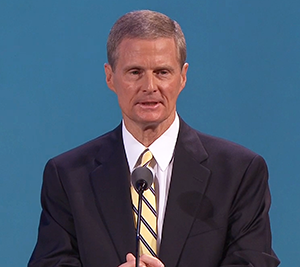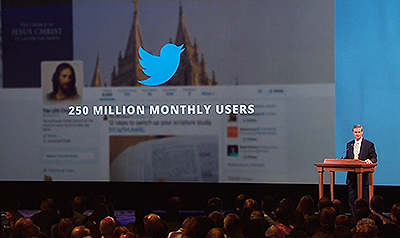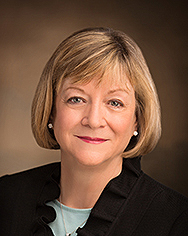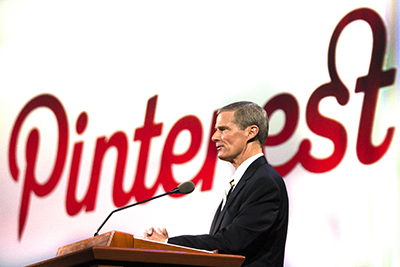Download: small, medium, large
Sister Bednar and I are grateful to worship together with you in this Brigham Young University Education Week devotional.
In 2009 I delivered a message to the young adults of the Church entitled “Things as They Really Are” and discussed the spiritual potential and pitfalls of various technologies in our modern world (see Ensign, June 2010, 16–25). My remarks today build upon and extend that previous message by focusing upon three related and important topics: (1) the unique season in the history of the world in which we live, even “the dispensation of the fulness of times,” (2) the inspired technological and communication innovations that have come forth in this decisive dispensation, and (3) how we appropriately use these powerful tools to advance the work of salvation in all of the world.
I pray the Holy Ghost will teach and edify each of us as we consider together true principles and how to apply those principles in our lives.
 The Dispensation in Which We Live
The Dispensation in Which We Live
We live in a truly distinctive dispensation.
A gospel dispensation is a period of time in which the necessary priesthood authority, ordinances, and doctrinal knowledge are found on the earth to implement the Father’s plan of salvation for His children. Essential to the establishment of a dispensation is an authorized servant of God, a dispensation head, who holds and exercises the authority and keys of the holy priesthood. Gospel dispensations were established through Adam, Enoch, Noah, Abraham, Moses, Jesus Christ, Joseph Smith, and others. In every dispensation gospel truths are revealed anew—or dispensed—so the people of that period are not entirely dependent upon past dispensations for knowledge of Heavenly Father’s plan.
Download: small, medium, large
Apostasy from the truth occurred in each previous dispensation. However, the work of salvation that was commenced but not completed in those earlier eras continues into the final dispensation. The Prophet Joseph Smith explained that for this reason, the rolling forward of the latter-day glory, even the dispensation of the fulness of times, “is a cause that has interested the people of God in every age; it is a theme upon which prophets, priests and kings have dwelt with peculiar delight; they have looked forward with joyful anticipation to the day in which we live; and fired with heavenly and joyful anticipations they have sung and written and prophesied of this our day” (Teachings of Presidents of the Church: Joseph Smith [2007], 186).
In this greatest and last of all gospel dispensations, “a whole and complete and perfect union, and welding together of dispensations, and keys, and powers, and glories should take place, and be revealed from the days of Adam even to the present time. And not only this, but those things which have never been revealed from the foundation of the world, but have been kept hid from the wise and the prudent, shall be revealed … in this, the dispensation of the fulness of times” (D&C 128:18).
The Prophet Joseph further expounded: “All the ordinances and duties that ever have been required by the Priesthood, under the directions and commandments of the Almighty in any of the dispensations, shall all be had in the last dispensation … , bringing to pass the restoration spoken of by the mouth of all the Holy Prophets” (Teachings: Joseph Smith, 511).
As the Apostle Paul declared, “In the dispensation of the fulness of times [God will] gather together in one all things in Christ, both which are in heaven, and which are on earth; even in him” (Ephesians 1:10).
The Dispensation of the Fulness of Times and Technology
 We are blessed to live, learn, and serve in this most remarkable dispensation. An important aspect of the fulness that is available to us in this special season is a miraculous progression of innovations and inventions that have enabled and accelerated the work of salvation: from trains to telegraphs to radios to automobiles to airplanes to telephones to transistors to televisions to computers to satellite transmissions to the Internet—and to an almost endless list of technologies and tools that bless our lives. All of these advancements are part of the Lord hastening His work in the latter days.
We are blessed to live, learn, and serve in this most remarkable dispensation. An important aspect of the fulness that is available to us in this special season is a miraculous progression of innovations and inventions that have enabled and accelerated the work of salvation: from trains to telegraphs to radios to automobiles to airplanes to telephones to transistors to televisions to computers to satellite transmissions to the Internet—and to an almost endless list of technologies and tools that bless our lives. All of these advancements are part of the Lord hastening His work in the latter days.
In 1862 Brigham Young said: "Every discovery in science and art, that is really true and useful to mankind has been given by direct revelation from God, though but few acknowledge it. It has been given with a view to prepare the way for the ultimate triumph of truth, and the redemption of the earth from the power of sin and Satan. We should take advantage of all these great discoveries, the accumulated wisdom of ages, and give to our children the benefit of every branch of useful knowledge, to prepare them to step forward and efficiently do their part in the great work” (Discourses of Brigham Young, sel. John A. Widtsoe [1954], 18–19).
In 1966 President David O. McKay prophesied scientific discoveries that “stagger the imagination” would make possible the preaching of the gospel to every kindred, tongue, and people. And further:
"Discoveries latent with such potent power, either for the blessing or the destruction of human beings, as to make man’s responsibility in controlling them the most gigantic ever placed in human hands. … This age is fraught with limitless perils, as well as untold possibilities” (in Conference Report, Oct. 1966, 4).
Please now listen to the voice of President Spencer W. Kimball, recorded in 1974, as he described the future of missionary work:
"I believe that the Lord is anxious to put into our hands inventions of which we laymen have hardly had a glimpse. …
“With the Lord providing these miracles of communication, and with the increased efforts and devotion of our missionaries and all of us, and all others who are ‘sent,’ surely the divine injunction will come to pass: ‘For, verily, the sound must go forth from this place into all the world, and unto the uttermost parts of the earth—the gospel must be preached unto every creature’ (D&C 58:64)” (“When the World Will Be Converted,” Ensign, Oct. 1974, 10–11).
And in 1981 President Gordon B. Hinckley taught: "We are confident that as the work of the Lord expands, he will inspire men to develop the means whereby the membership of the Church, wherever they may be, can be counseled in an intimate and personal way by his chosen prophet. Communication is the sinew that binds the Church as one great family. Between those facilities which are now available and those which are on the horizon, we shall be able to converse one with another according to the needs and circumstances of the time” (“Faith: The Essence of True Religion,” Ensign, Nov. 1981, 5).
Messages and pictures that used to require days, weeks, and months to send and receive now can be communicated around the world in seconds. We thank thee, O God, for the prophets who have taught and prepared us for the time in which we live—and who have urged us to use technological advancements to support the ongoing mission of The Church of Jesus Christ of Latter-day Saints.
In June of 2013, Elder L. Tom Perry described the impact of digital technologies on missionary work. He said:
“When I was a young missionary, we were able to speak with contacts on the street and knock on doors to share the gospel. The world has changed since that time. Now, many people are involved in the busyness of their lives. They hurry here and there, and they are often less willing to allow complete strangers to enter their homes, uninvited, to share a message of the restored gospel. Their main point of contact with others, even with close friends, is often via the Internet. The very nature of missionary work, therefore, must change if the Lord is to accomplish His work of gathering Israel ‘from the four corners of the earth’ (2 Nephi 21:12). The missionaries are now authorized to use the Internet in their proselyting efforts. ...
“As missionaries enter this new age where they will use computers in the work of the Lord, we invite the young and the old, the adults, the young adults, the youth, and the children everywhere to join with us in this exciting new work by becoming Facebook friends with the missionaries in your area on your own computers and sharing their gospel messages online and by becoming involved in missionary work yourselves” (“Missionary Work in the Digital Age"[worldwide leadership training meeting, June 2013]; ChurchofJesusChrist.org/broadcasts).
Approximately 40 percent of our worldwide missionary force soon will be using digital devices as tools in the work of conversion, retention, and activation. I am confident all of us also recognize how technology has accelerated family history and temple work, our individual and family study of the restored gospel, and made it possible for us to learn about, see, and experience the world in remarkable ways.
Social Media
A technology known as social media is evolving in our day and playing an increasingly important role in hastening the work of salvation. The term social media refers to various channels of Internet and mobile-based communication that are used by individuals, families, and large groups of people to create digital communities wherein they share information, ideas, personal messages, and other content such as pictures and videos.
The popularity and reach of current social media tools are staggering. For example, Facebook is a networking service used to share messages, images, links, and videos with family, friends, and followers—and has approximately 1.2 billion average monthly users.

YouTube is a platform through which videos can be distributed, viewed, rated, and shared—and has approximately one billion average monthly users.
Twitter is a means of sending and receiving short, quick text messages and images called tweets—and has approximately 250 million average monthly users.
Instagram allows the sharing of pictures and short videos—and has approximately 150 million average monthly users.
Pinterest is a virtual bulletin board used to collect and share content and images from around the web—and has approximately 70 million average monthly users.
Please note that I have identified only five of the presently popular social media channels; many other such channels are being used by tens of millions of people. And new methods of and channels for digital communication are being developed constantly.
The Lord is hastening His work, and it is no coincidence that these powerful communication innovations and inventions are occurring in the dispensation of the fulness of times. Social media channels are global tools that can personally and positively impact large numbers of individuals and families. And I believe the time has come for us as disciples of Christ to use these inspired tools appropriately and more effectively to testify of God the Eternal Father, His plan of happiness for His children, and His Son, Jesus Christ, as the Savior of the world; to proclaim the reality of the Restoration of the gospel in the latter days; and to accomplish the Lord’s work.
I now want to present several examples of gospel messages and images that have been created by the Church and by its members and communicated to the world through social media.
Download: small, medium, large
Example 1. Because of Him
To honor the true meaning of Easter, the Church earlier this year produced and distributed a two minute and 40 second video entitled Because of Him. This message focused on the hope, healing, and salvation made possible through the Atonement of Jesus Christ.
Because the Church, its members, and those of other faiths actively shared the video on social channels, it was viewed more than five million times during Easter week in 191 countries and territories of the world.
 The Church also invited members and others to create and share their own Easter messages by using the #BecauseofHim hashtag. A hashtag is used to identify related social media messages. As a consequence of this initiative, numerous thoughts and images about the Savior and His Resurrection were communicated in many social channels and places, including Facebook, Twitter, and Instagram.
The Church also invited members and others to create and share their own Easter messages by using the #BecauseofHim hashtag. A hashtag is used to identify related social media messages. As a consequence of this initiative, numerous thoughts and images about the Savior and His Resurrection were communicated in many social channels and places, including Facebook, Twitter, and Instagram.
Example 2. Did You Think to Pray
Members of the Church and others published photos of themselves on Instagram, Facebook, Twitter, and other social channels with signs that completed the phrase “I pray when …”
More than 300 photos were published. In addition, thousands of people used the #DidYouThinktoPray hashtag to share thoughts about when and why they communicate with their Heavenly Father.
Through the simple action of writing a few meaningful words on a small sign and sharing it on social media—something any of us can do—those who participated in this initiative touched hundreds of thousands of lives for the better and led to more than 40,000 conversations about the need for prayer.
Example 3. Book of Mormon 365
 The Book of Mormon 365 Instagram account is a prime example of a simple idea that has allowed members to foster spiritual growth through social media.
The Book of Mormon 365 Instagram account is a prime example of a simple idea that has allowed members to foster spiritual growth through social media.
The idea is simple. The account creators—Ben and Chelsea Prince from Arizona—post a reading assignment from the Book of Mormon every day. The assignments are divided into 365 pieces—the perfect size to allow followers to read the full Book of Mormon in one year.
The results have been astounding. More than 45,000 people now follow this Instagram account, with many of them actively sharing their thoughts and impressions with one another as they read the Book of Mormon together.
Example 4. General Authority Social Media Accounts
 This summer the Church established an official Instagram account. In late June and early July, images were shared of President Monson and President Eyring at the Gilbert Arizona cultural celebration, President Monson and President Eyring at a temple dedication, and President Uchtdorf meeting a young girl during a recent trip to Switzerland.
This summer the Church established an official Instagram account. In late June and early July, images were shared of President Monson and President Eyring at the Gilbert Arizona cultural celebration, President Monson and President Eyring at a temple dedication, and President Uchtdorf meeting a young girl during a recent trip to Switzerland.
What is unique about these photos? The members of the First Presidency themselves specifically chose the photos to be posted. You also may have noticed that some of the Brethren now have their own Twitter accounts, including Elder Ballard, Elder Holland, and me. Additional members of the Twelve may be active on Twitter in the near future. All of the Brethren also have their own Facebook pages on which they communicate important gospel messages.

Social media are helping the leaders and members of the restored Church to fulfill the Lord’s mandate to “go ye into all the world, and preach the gospel to every creature” (Mark 16:15; italics added).
Example 5. #LDSconf
 Many of you noticed the #LDSconf hashtag that was displayed on the lower left corner of the screen during the October 2013 and April 2014 general conference broadcasts. What you may not know is that members have used this hashtag to promote general conference for years. The first use of the #LDSconf hashtag dates back to October 2008, when it was created by a faithful member looking for an opportunity to follow and share conference-related tweets—long before the Church started using it.
Many of you noticed the #LDSconf hashtag that was displayed on the lower left corner of the screen during the October 2013 and April 2014 general conference broadcasts. What you may not know is that members have used this hashtag to promote general conference for years. The first use of the #LDSconf hashtag dates back to October 2008, when it was created by a faithful member looking for an opportunity to follow and share conference-related tweets—long before the Church started using it.
As you can see from these examples on the screen, thousands of members join together twice a year to participate in the #LDSconf hashtag conversation about the things they learn and feel as they receive counsel from living prophets and apostles. Through this channel, millions of people around the world are edified by general conference messages.
Example 6. Meet the Mormons
I have one final example of gospel content that can be shared through social media channels.
A few years ago, the First Presidency approved the production of a feature-length film to help those not of our faith better understand Latter-day Saints as a people. This new film, titled Meet the Mormons, originally was scheduled to be shown exclusively in the Legacy Theater in Salt Lake City and in visitors’ centers around the world. However, with the growth of the social media technologies we have discussed today, we realized that worldwide distribution of the film was now possible through various digital channels. As Elder M. Russell Ballard explained: “In Shakespeare’s time, he was limited generally to the Globe Theatre, but we now have a global theater. … The doors to the world are literally opened wide” (“When Shall These Things Be?” [Brigham Young University devotional, Mar. 12, 1996], 6; speeches.byu.edu).
Meet the Mormons addresses common misperceptions about our beliefs and highlights the blessings that come from living the gospel of Jesus Christ. The film will be released after October general conference in several media and channels—first in select theaters in the United States and then, later, in visitors’ centers and on television, Internet movie channels, and social media channels.
We will now see a brief trailer from the film.
For more information on the film, you can visit meetthemormons.com. This movie is one additional way members can share their beliefs with family and friends in a simple and effective way.
Social Media Guidelines
These six examples of Church- and member-generated content illustrate several basic guidelines that should be followed as we use social media to convey gospel messages.
Download: small, medium, large
Be Authentic and Consistent
First, we are disciples and our messages should be authentic. A person or product that is not authentic is false, fake, and fraudulent. Our messages should be truthful, honest, and accurate. We should not exaggerate, embellish, or pretend to be someone or something we are not. Our content should be trustworthy and constructive. And anonymity on the Internet is not a license to be inauthentic.
Authenticity is strengthened through consistency. The gospel messages you share will be accepted more readily if your Christlike example is evident in the ongoing pattern of your posts.

Photo by Busath.com
Sister Bonnie L. Oscarson is a strong example of the power of consistency in social media. When called to serve as the Young Women general president in April of 2013, her Pinterest followers doubled overnight. Sister Oscarson’s previous pins provided ample evidence of her integrity, prompting one blogger to ask, “Would your Pinterest page pass the Bonnie Oscarson test? … Who will people decide you are if all they know is what is on your social media page?” (www.latterdaysaintwoman.com/would_your_pinterest_page_pass_the_bonnie_oscarson_test).
Edify and Uplift
Second, we and our messages should seek to edify and uplift rather than to argue, debate, condemn, or belittle. As Paul counseled the Ephesians, “Let no corrupt communication proceed out of your mouth, but that which is good to the use of edifying, that it may minister grace unto the hearers” (Ephesians 4:29).
Brothers and sisters, share the gospel with genuine love and concern for others. Be courageous and bold but not overbearing in sustaining and defending our beliefs, and avoid contention. As disciples our purpose should be to use social media channels as a means of projecting the light and truth of the restored gospel of Jesus Christ into a world that increasingly is dark and confused.
Respect Intellectual Property
Third, we and our messages should respect the property of other people and organizations. This simply means that you should not create your own content using someone else’s art, name, photos, music, video, or other content without permission. To assist you in creating uplifting gospel messages, we are pleased to announce that the content in the Media Libraryon ChurchofJesusChrist.org, unless otherwise indicated, has been cleared for use by members without seeking permission from the Church.Additional information about the use of Church media can be found at social.ChurchofJesusChrist.org.
When you share messages online, make sure others understand that you are expressing your personal thoughts and feelings. Please do not use the Church logo or otherwise suggest that you are speaking for or on behalf of the Church.

Be Wise and Vigilant
Fourth, be wise and vigilant in protecting yourself and those you love. We should remember that the Internet never forgets. Anything you communicate through a social media channel indeed will live forever—even if the app or program may promise otherwise. Only say it or post it if you want the entire world to have access to your message or picture for all time.
Following these simple guidelines will enable members of the Church around the world to create and share gospel messages that will cause the light to “shine forth out of darkness” (Mormon 8:16).
An Apostolic Invitation
In my message, “Things as They Really Are,” that I referred to earlier, I described some of the positive and negative consequences of computer-mediated communication. I highlighted the truth that technology in and of itself is neither inherently good nor bad. Rather, the purposes accomplished with and through technology are the ultimate indicators of goodness or badness.
Download: small, medium, large
I emphasize again what President David O. McKay indicated many years ago about the scientific discoveries of our age: “Discoveries latent with such potent power, either for the blessing or the destruction of human beings, as to make man’s responsibility in controlling them the most gigantic ever placed in human hands. … This age is fraught with limitless perils, as well as untold possibilities.”
In “Things as They Really Are,” I raised a voice of warning about the perils:
“I raise an apostolic voice of warning about the potentially stifling, suffocating, suppressing, and constraining impact of some kinds of cyberspace interactions and experiences upon our souls. The concerns I raise are not new; they apply equally to other types of media, such as television, movies, and music. But in a cyber world, these challenges are more pervasive and intense. I plead with you to beware of the sense-dulling and spiritually destructive influence of cyberspace technologies that are used to produce high fidelity and that promote degrading and evil purposes” (Ensign, June 2010, 20).
That warning is even more valid today than it was five years ago. Too much time can be wasted, too many relationships can be harmed or destroyed, and precious patterns of righteousness can be disrupted when technology is used improperly. We should not allow even good applications of social media to overrule the better and best uses of our time, energy, and resources.
These perils indeed are real, but so too are the extraordinary opportunities. I now want to build upon my previous warning about potential perils by extending an important invitation about powerful possibilities.
The examples of gospel messages we have seen today that were created for and conveyed through social media channels are wholesome, good, and have influenced positively tens of thousands of people. They represent an excellent beginning—but only a beginning. Let me briefly describe what I believe needs to come next.
In the seventh chapter of the book of Moses in the Pearl of Great Price, Enoch foresees the Restoration of the gospel in the latter days, the gathering of Israel, the Second Coming of the Savior, and the return of Zion. I now invite your undivided attention as we consider together elements of four verses from this chapter:
“And Enoch beheld the Son of Man ascend up unto the Father; and he called unto the Lord, saying: … wherefore, I ask thee if thou wilt not come again on the earth.
“And the Lord said unto Enoch: As I live, even so will I come in the last days, in the days of wickedness and vengeance. …
“And the day shall come that the earth shall rest, but before that day the heavens shall be darkened, and a veil of darkness shall cover the earth; and the heavens shall shake, and also the earth; and great tribulations shall be among the children of men, but my people will I preserve;
“And righteousness will I send down out of heaven; and truth will I send forth out of the earth, to bear testimony of mine Only Begotten; his resurrection from the dead; yea, and also the resurrection of all men; and righteousness and truth will I cause to sweep the earth as with a flood” (Moses 7:59–62; italics added).
My beloved brothers and sisters, what has been accomplished thus far in this dispensation communicating gospel messages through social media channels is a good beginning—but only a small trickle. I now extend to you the invitation to help transform the trickle into a flood. Beginning at this place on this day, I exhort you to sweep the earth with messages filled with righteousness and truth—messages that are authentic, edifying, and praiseworthy—and literally to sweep the earth as with a flood.

I pray we will not simply participate in a flash flood that rises swiftly and then recedes just as rapidly. I am not suggesting a one-time glitzy initiative from which we quickly move on to the next task on our lengthy list of gospel things to do. We need not become social media experts or fanatics. And we do not need to spend inordinate amounts of time creating and disseminating elaborate messages. As Elder M. Russell Ballard recently taught, digital technologies should be our servants and not our masters (see M. Russell Ballard, “Be Still, and Know That I Am God” [Church Educational System devotional, May 4, 2014]; broadcasts.ChurchofJesusChrist.org).
According to our desires and circumstances, each of us can contribute consistently to the growing flood of truth and righteousness. We should press forward using the Lord’s pattern of “line upon line, precept upon precept, here a little and there a little” (2 Nephi 28:30).
Imagine the impact we can have as hundreds of thousands and millions of members of the Lord’s restored Church contribute in seemingly small ways to the rising floodwaters. May our many small, individual efforts produce a steady rainfall of righteousness and truth that gradually swells a multitude of streams and rivers—and ultimately becomes a flood that sweeps the earth. “Wherefore, be not weary in well-doing, for ye are laying the foundation of a great work. And out of small things proceedeth that which is great” (D&C 64:33).
Promised Blessings and Testimony
We have been and are blessed in so many ways; and where much is given, much is required. As an Apostle of the Lord Jesus Christ, I invoke this blessing upon you: that you may come to understand more fully the spiritual significance and blessing of living in the dispensation of the fulness of times, that you may have eyes to see clearly both the possibilities and the pitfalls of the remarkable technologies that are available to us today, that you may increase in your capacity to use these inspired tools appropriately, and that you may receive inspiration and guidance about the role you should play in helping to sweep the earth as with a flood of truth and righteousness. As you press forward in this holy work, I promise you will be blessed in mortality in the individual, specific, and necessary ways that will prepare you for eternity. I so bless you.
I witness the Father and the Son live. The Savior stands at the head of His Church in these latter days. He is hastening His work, and no unhallowed hand can stop this work from progressing. Of these things I testify in the sacred name of the Lord Jesus Christ, amen.



